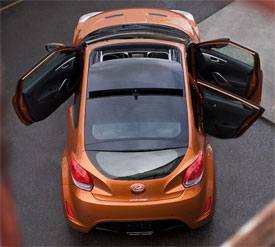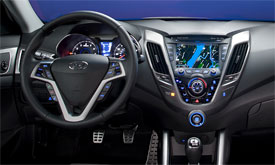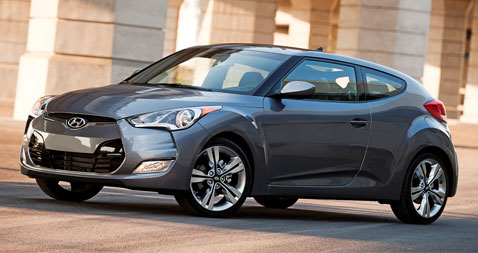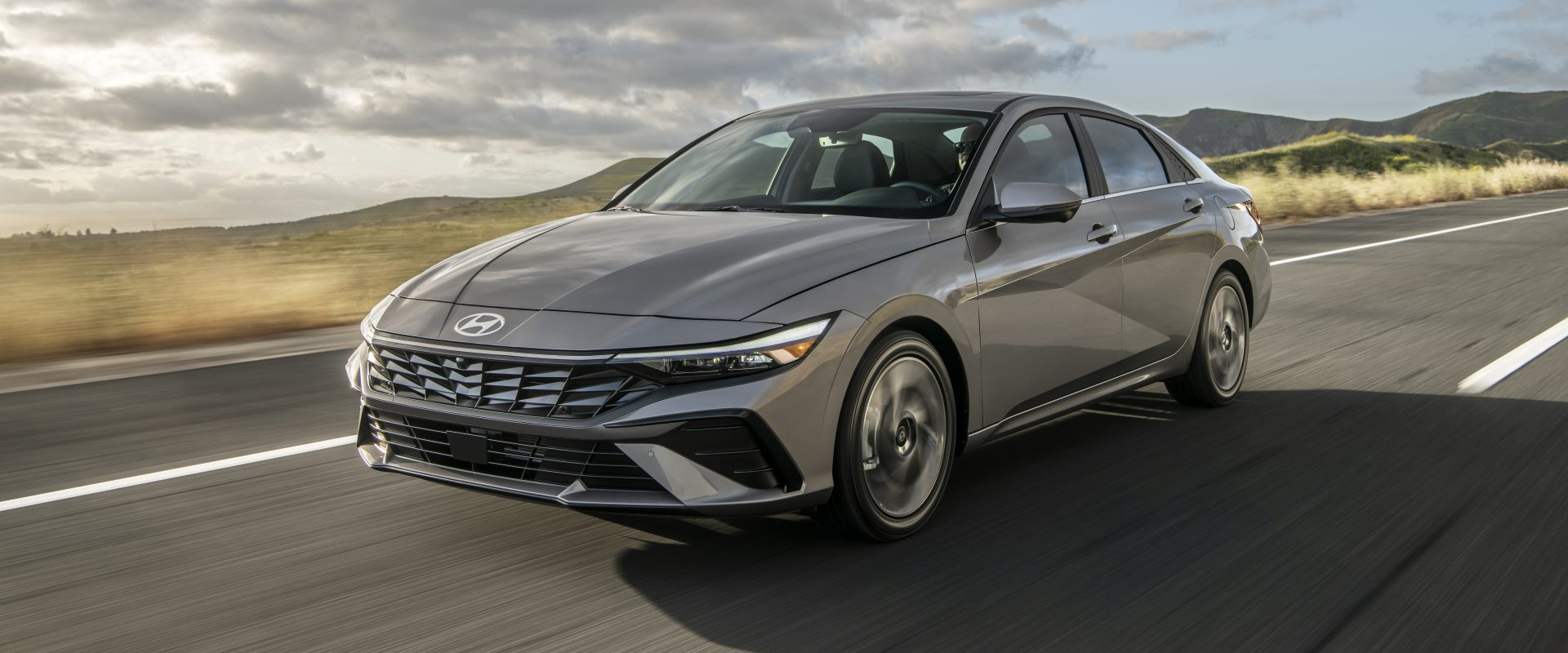2012 Hyundai Veloster
The 2012 Hyundai Veloster is indeed unlike any Hyundai before. Not only does it look way sportier than anything else from the Korean brand to this point, this sub-compact, front-wheel drive sport-coupe comes with something unique to its type…a third door. Yes, we know it’s been done before. Remember the Saturn Coupe, and the current Mini Clubman, among others. They all include a rear hinged access door.
But, surprise, the Veloster’s rear door is not a short panel but a full-size, front swinging door, opened by a nicely hidden handle mounted high in the C-pillar. The advantages for rear access are obvious. But the uniqueness doesn’t end there, apart from the familiar hexagon Hyundai grille not much about this hot little hatch says “I’m from Korea!”
 Yeah, we also know, Hyundai’s have gotten a lot more stylish over the last couple of years, but nothing close to the Veloster’s sporty approach; with a helmet visor-like wraparound windshield and side glass. Scooped out body lines are everywhere, including in the rear hatch, where everything seems to point to the center, dual exhaust tips. 17-inch wheels are standard, but our car’s Tech package features 18’s with body colored inserts, and a glass panoramic roof is optional.
Yeah, we also know, Hyundai’s have gotten a lot more stylish over the last couple of years, but nothing close to the Veloster’s sporty approach; with a helmet visor-like wraparound windshield and side glass. Scooped out body lines are everywhere, including in the rear hatch, where everything seems to point to the center, dual exhaust tips. 17-inch wheels are standard, but our car’s Tech package features 18’s with body colored inserts, and a glass panoramic roof is optional.
But, it doesn’t take too much time behind the wheel to realize that there’s a lot more show than go to the Veloster. The direct-injection 1.6-liter I4 engine comes from the Hyundai Accent and puts out the same, modest 138-horsepower and 123 pound feet of torque.
However, our 6-speed manual equipped test car does have great Government Fuel Economy Ratings of 28-City and 40-Highway. We averaged only 32.3 miles-per-gallon of Regular in mixed driving, but that’s probably because we had the throttle mashed all the way down all the time. A 6-speed EcoShift Dual Clutch automatic transmission is available, but that doesn’t quite qualify for the 40 MPG club.
Ride quality is very good - not too harsh, not too soft; but when you start pushing, things fall apart pretty quickly. As we found out at our test track where the MacPherson strut front and torsion beam rear suspension from the Hyundai Elantra, became quickly overwhelmed. Under steer is quite pronounced, but the car actually stays fairly flat; the 18-inch wheels with sticky tires help. The electrically assisted steering is quick, but devoid of all feel making for some interesting moments through the slalom.
Even more underwhelmed were we, when it came to acceleration runs. Launches to 60 took 8.6-seconds, while the ¼ mile passed in 16.8-seconds at 83 miles-per-hour. While that’s really not too bad for a 1.6-liter, the Veloster’s looks promise so much more. Braking performance from the 4-wheel ABS equipped discs with Brake Assist was very good - 122 feet from 60 with a fairly solid pedal.
There is one other area where the Veloster really delivers, the interior. We love the motorcycle inspired design - big, podded gauges, the center stack is shaped to resemble a sport bike fuel tank, while the center console mirrors the bike’s seat, and the climate vents mirror exhaust tips. It’s a very cool look, from the loop door handles to the center mounted start button. All controls are stylish, intuitive, and work well. Steering wheel controls and Bluetooth are standard.
 Seats are firm, and covered with funky looking cloth. Access to the rear seat through that single rear side door is tight, and there’s a serious lack of head room once you’re in there. Still, it’s better than a Euro-style 2+2. Seat backs fold to expand the useful 15.5 cubic-feet of trunk space to a big 34.7.
Seats are firm, and covered with funky looking cloth. Access to the rear seat through that single rear side door is tight, and there’s a serious lack of head room once you’re in there. Still, it’s better than a Euro-style 2+2. Seat backs fold to expand the useful 15.5 cubic-feet of trunk space to a big 34.7.
The Veloster is also the first car to bring Hyundai’s new Blue Link telematics to market. It’s an Onstar like system with various services available. Our car’s upgraded 450-watt Dimension Premium Audio system cranked out some serious vibration with a subwoofer in the trunk. The Tech package adds a Navigation system with back-up camera and backup warning sensors, push button start, and a 115-volt household outlet in the center console.
And, here’s another high point - low pricing. The Veloster begins at just $18,060 with the aftermarket already gearing up with Scion-style add-ons. Without a doubt, the 2012 Hyundai Veloster is striking and different, even if its current performance high point is fuel economy. But, for an affordable, head turning little runabout, it works. And, this is just the first act. A Veloster Turbo is due next summer. So, soon this little coupe will go as fast as it looks.
Specifications
- Engine: 1.6-liter I4 engine
- Horsepower: 138
- Torque: 123 lb-ft
- 0-60 mph: 8.6-seconds
- 1/4 mile: 16.8-seconds at 83 mph
- EPA: 28 mpg city/ 40 mpg highway
2024 Hyundai Elantra
Basic Transportation At Its Best…And That Is A Compliment
For those of you who write in every week bemoaning the fact that all we seem to do around here is test incredibly expensive cars and EVs that only the very well to do can afford, this one’s for you. It’s a commuter and budget friendly mainstay from Hyundai, the compact Elantra sedan. And, it has been nicely updated for 2024.
We clearly do enjoy driving high-performance machines and ultra-luxury rides around here, but like most of you, when it comes time to drive home at the end of a long workday, we do so in something much more practical and affordable, like this 2024 Hyundai Elantra sedan.
If you’re thinking the front end has gotten more aggressive, you’re right. Hyundai calls it a “Shark Nose” theme, and we’re guessing they were thinking more Great White than Hammerhead, though Megamouth shark would also apply. It helps for a low and wide look; more substantial than the typical compact. Other additions for ’24 include slimmer daytime running lights, revised stainless steel Hyundai emblem, reshaped front fenders, sport sedan-style rear diffuser with silver trim; a parametric pattern added to the C-Pillar, and new LED taillights that take up a lot more space on the highly sculpted decklid. Plus, new wheel designs in sizes ranging from 15- to 18-inches.
Standard engine in SE, SEL, and Limited grades is this naturally aspirated 2.0-liter I4 with 147 horsepower and 132 lb-ft of torque. Even with no hybrid assistance, it gets substantial Government Fuel Economy Ratings of 31 City, 40 Highway, and 34 Combined; we averaged a great 38.6 mpg of Regular.
Those high fuel economy numbers mean acceleration times are pretty high as well. It was in no particular hurry to get off the line at our test track, as after a slight jolt of power, it felt pretty sluggish going down the track, taking us a lengthy 9.4 seconds to hit 60 mph. Hyundai’s Intelligent Variable Transmission has some realistic simulated gear shifts built in, and they not only provided the feel of a true automatic, but kept engine noise from becoming overbearing. And while this 2.0-liter may not be a house-on-fire off the line, it has no problem keeping up with traffic, and feels like just the perfect amount of power for a practical and safe commuter car.
There are other engine options too. Two choices if you want to go faster, a 1.6-liter turbo with 201 horsepower in the Elantra N Line, and a 276-horsepower turbocharged 2.0-liter for the Elantra N; plus, one with even better fuel economy, a 1.6-liter hybrid with a 139 horsepower total output.
And despite some significant understeer, there was good feel through the cones of our handling course, both in steering and chassis feedback. We wouldn’t quite call it “point and shoot,” but it responded to inputs fairly quickly, with only moderate body roll. All-in-all, when it comes to performance, it doesn’t claim to bring a whole lot to the table, but does clearly overachieve with what it does bring.
And Hyundai is always overachieving when it comes to packing in features, yet has found a way of keeping things refreshingly simple with a good mix of touchscreen and manual controls. Lots of space too, both up front in the surprisingly wide front buckets, and in the rear bench with ample room for three. Updates for all Elantra interiors include softer materials on the door panels, upgraded instrumentation and additional charging ports, plus a surround view monitor and new H-Tex simulated leather for Limited trim.
Elantra pricing starts with an SE at $22,775, the SEL comes in at $24,725, Limited begins at $28,215, and the sporty N Line starts at $29,615. If you’re interested in the hybrid, base Blue starts at $27,400 with Limited at $30,600.
Some might say there’s not a whole lot that’s earth shaking about the 2024 Hyundai Elantra, but that’s mostly why we like it so much. When it comes to just delivering good, basic transportation with a high dose of unexpected amenities, Hyundai delivers once again.
Specifications
- Engine: 2.0-liter I4
- Horsepower: 147
- 0-60 mph: 9.4 seconds
- 60-0 Braking: 111 ft (avg)
- MW Fuel Economy: 38.6 MPG (Regular)
- Transmission: IVT
- Torque: 132 lb-ft
- 1/4 Mile: N/A (Track Maintenance)
- EPA: 31 City / 40 Highway / 34 Combined







